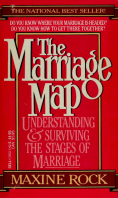 |
Full Title: | The Marriage Map Understanding and Surviving the Stages of Marriage |
|---|---|---|
| Author(s): | Maxine Rock | |
| Publishing / Edition: | Dell Publishing, 1986 |
 |
Full Title: | The Marriage Map Understanding and Surviving the Stages of Marriage |
|---|---|---|
| Author(s): | Maxine Rock | |
| Publishing / Edition: | Dell Publishing, 1986 |
Stage One: FANTASY TIME (years one to three) is when you think everything about your new mate is wonderful...and if it isn't, his or her faults are "cute" rather than annoying. This foggy state of young marriage is commonly known as the "honeymoon period".
Stage Two: COMPROMISE (years two to seven) is the couple's first encounter with mutual disappointment. You realise that you are, indeed, annoyed or hurt by certain of your spouse's traits or habits. This is a dangerous time, when many marriages dissolve in divorce. You begin negotiations aimed at persuading the spouse to change, and you promise to make changes of your own in return.
Stage Three: REALITY STRUGGLES (years five to ten) brings the realization that while some compromises may stick, you and your spouse aren't going to change much at all. You must force yourself to understand and accept the other person's limitations. The reality is that he or she cannot live up to your ideal. More permanent bonding takes place here, often produced by having children and further combining finances.
Stage Four: DECISIONS (years ten to fifteen) comes right after a person accepts reality...and doesn't like it very much. Now that you know the partner's bad points are here to stay, can you honestly say his or her good points make up for them? Can you change enough to cope with those bad points so they don't interfere with the continued growth of the marriage?
Stage Five: SEPARATION (years twelve to seventeen) often seems like the only option when you can't make up your mind to cope...or to flee and perhaps divorce. Separation could mean living apart for a while or living together but feeling aloof and alienated from one another. This stage, perhaps the most painful point on the Marriage Map, ends when couples start talking about specific ways to alter their lives so they can remain married. There is great relief in knowing the other person cares enough to make the effort of such discussion.
Stage Six: TOGETHER AGAIN (years seventeen to twenty) begins when you realize that despite what may be some irreconciliable differences, you want to stay married. The commitment is not only to one another but to the concept of preserving and enhancing your growth as a couple - no matter what. People in this stage usually stop thinking or talking about divorce. It is no longer an option for them.
Stage Seven: NEW FREEDOM (years twenty to twenty-five and beyond) is a release from the pressures of making up and trying to fit comfortably into the new emotional lifestyle you have created with your spouse. Now the relationship flows quite naturally. People stop wondering what the husband or wife is thinking and stop trying so hard to please. It really doesn't matter, because you are - at last - fully accepted and accepting. This is a time of surging personal growth. Both partners are free to explore new ways of fulfilling themselves, instead of pouring so much energy into the marriage. The New Freedom marks what many people consider the beginning of the best years of marriage.
ONGOING GROWTH continues the expansion of personal horizons within a marriage that has successfully gone through all the stages. Ongoing Growth is not a stage itself, because it has no end. It is the rich, ripe reward for growing together while remaining enough of an individual to grow separately as well.